1、导入模块+创建连接
import pymysql # 1、通过python去连接数据库 conn = pymysql.connect(host="127.0.0.1",port=3306,user="root",passwd="admin123.",db="test_python_1",charset="utf8")
2、创建游标,通过游标就可以执行sql命令
# 2、创建游标 test_cursor = conn.cursor()
3、通过游标执行sql命令,插入一条数据
插入前的表的内容
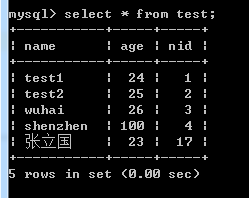
执行命令
# 3、执行一个插入的命令
r = test_cursor.execute("insert into test(name,age) VALUES ('999',23)")
这里的r的值就受影响的行的数目
这里要注意,如果执行修改相关的命令,则必须要commit才能生效,commit操作由数据库连接的对象的操作,而不是通过游标去执行
# 4、提交数据 conn.commit()
查看表中的内容,已经多了一条数据
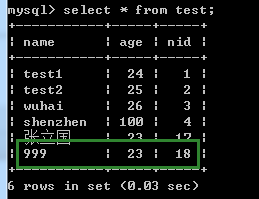
4、python的数据交互,由pymysql内部做参数传递
inp = input("请输入姓名:")
r = test_cursor.execute("insert into test(name,age) VALUES (%s,34)",inp)
# 这里可以用字符串拼接,也可以使用pymysql内部给我们做字符串拼接
# 字符串拼接是可以的,但是这里禁止操作的,这里会引起sql注入,所以不能这么使用
print(r)
# 这里的r的意思受影响的行数
我们看表中的数据已经更新
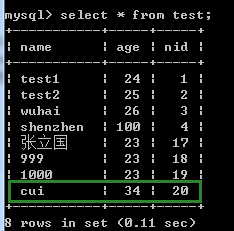
上面只传递了一个参数,如果有多个参数,该怎么传递呢?这里要传递一个元组进去
inp = input("请输入姓名:")
inp_age = input("请输入年龄:")
r = test_cursor.execute("insert into test(name,age) VALUES (%s,%s)",(inp,inp_age))
我们看到数据库的表中的数据已经更新

上面的例子我们只插入了一条数据,那么如果我们想一次插入多条数据该怎么弄呢?解决办法看下面的例子,要用excutemany命令来执行,然后通过列表或者元组把参数传递进去
user_info_list = [
("cui1",23),
("cui2",24),
("cui3",25)
]
r = test_cursor.executemany("insert into test(name,age) values (%s,%s)",user_info_list)
print(r)
我们可以看到数据库的表中已经有数据更新
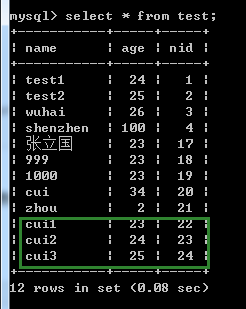
4、通过pymysql更新数据库中的内容
r = test_cursor.execute("update test set name = %s where age = 25","张国军")
print(r)
我们可以看到数据库的表中的内容已经更新
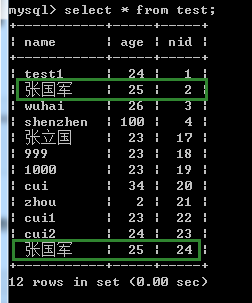
5、通过pymysql删除数据库表中的内容
r = test_cursor.execute("delete from test where age = 25")
print(r)
我们可以看到表中的数据已经更新
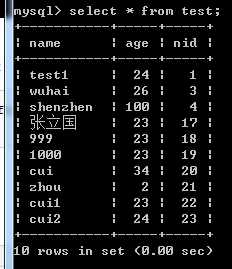
6、通过pymysql查询数据,如果是查数据,则不需要commit
r = test_cursor.execute("select * from test")
print(test_cursor.fetchone())
print(test_cursor.fetchone())
print(test_cursor.fetchmany(2))
print(test_cursor.fetchall())
我们注意数据库中的内容
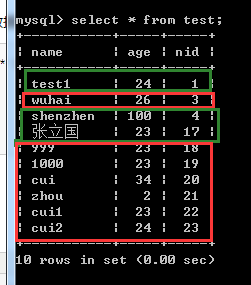
我们看pymysql得到的结果

我们可以看到上面有一个指针的概念,第一条数据被取出来后,第二次在取数据,则就从第二条数据开始取,那么我们有没有办法移动指针呢?当然有,我们看下面的例子
7、移动指针
绝对的方式移动指针
r = test_cursor.execute("select * from test")
print(test_cursor.fetchone())
test_cursor.scroll(0,mode = "absolute")
# 这里的意思,absolute是绝对的意思,让指针回到0的位置
print(test_cursor.fetchone())
我们可以看到2次取的数据是一样的

相对的方式移动指针
r = test_cursor.execute("select * from test")
print(test_cursor.fetchone())
# test_cursor.scroll(0,mode = "absolute")
# 这里的意思,absolute是绝对的意思,让指针回到0的位置
test_cursor.scroll(2,mode="relative")
# 这里的意思,relative是相对的意思,相当当前的位置向下移动2个位置,这里如果是负数的话,是向上移动,如果是正数,则向下移动
我们注意数据库中的表的顺序

我们看下pymysql执行的结果
